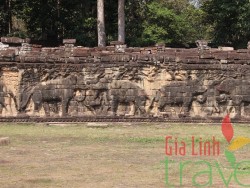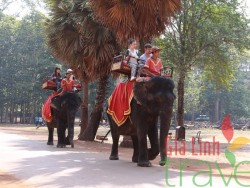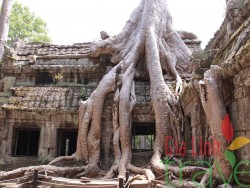Terrace of the Elephants
Siem Reap


South Gate of Angkor Thom

Ta Prohm
Siem Reap has colonial and Chinese-style architecture in the Old French Quarter, and around the Old Market. In town, there are Apsara dance performances, craft shops, silk farms, rice-paddy countryside, fishing villages and a bird sanctuary near the Tonle Sap Lake.
Siem Reap today, being a popular tourist destination, has a large number of hotels and restaurants. Most smaller establishments are concentrated around the Old Market area, while more expensive hotels are located between Siem Reap-Angkor International Airport and the town along National Road 6. There are a variety of mid-range hotels and restaurants along Sivatha, and budget to mid-range hotels in the Phsar Leu area.
Siem Reap and Angkor Temples
The world-renowned temples of Angkor are situated in the nor-western province of Siem Reap. Within an area of approximately 600 square kilometers, over 100 temples have been discovered. All were built between the 9th and the 13th centuries, and those remaining temples constitute the skeleton of what was once the religious and administrative centre of the Khmer Empire.
The constant building program undertaken by successive Khmer kings can be compared-favorably –with the pyramid construction projects of the Pharaohs in Egypt. Similarly to the Pharaohs, the Khmer kings made use of a vast force of slave labor. Each new “project” was made possible by the 750,000 people estimated to have lived at Angkor during the 12th and 13th centuries. Despite the scores of temples that remain today, there is little evidence of these nameless souls who lived in what must have been one of the biggest cities on earth at the time. This is because the people-everyone from the lowliest peasant to the King’s most senior courtiers-lived in wooden structures, all of which have long-since rotted away in the tropical heat. Only gods could live in stone, or in this case, the god-kings of the Khmer nation.
Portuguese travelers are believed to have been the first westerners to gaze in wonder at the temples of Angkor while journeying during the 16th Century. However, most credit for the “discovery” of Angkor has fallen to French botanist Henri Mouhot, whose visit to Angkor in 1860 was posthumously documented in Paris in 1868. During the remainder of the 19th Century and into the 20th Century, several French expeditions visited the temples and work was carried out to clear the jungle, which had enveloped most of the monuments. In 1907, Thailand returned control of Angkor to Cambodia and in the same year the first tourists arrived.
In the early days of tourism, visitors to Angkor followed one of two circuits to see the temples, the Little (Petit) Circuit or the Big (Grand) Circuit. These were often undertaken on the back of an elephant. Today things are different, and air-conditioned vehicles make the experience significantly more comfortable.
If time is limited, visitors may choose to follow “the Petit Circuit”, which includes visits to the Royal City of Angkor Thom with its numerous temples, Angkor Wat, the royal bathing pool of Sras Srang, and several other monuments. Extended tours continue to the “Grand Circuit”, visiting a number of other temples and an Angkorean reservoir. If time allows, tourists may also arrange to visit other prestigious temples such as Banteay Srey or Banteay Samre, situated slightly further from the main temple complex.
Angkor Wat
There are few places anywhere on earth to match the splendour of Angkor Wat. The temple is one of the largest monuments to religion ever built and is truly one the wonders of the world. Believed to have been constructed as a temple and mausoleum for King Suryavarman II at the peak of the Khmer empire in the first half of the 12th century, Angkor Wat is probably the best-preserved of the Angkorean temples. As with other Angkorean temples and walled cities such as Angkor Thom, the central theme of Khmer architecture revolved around the idea of the temple-mountain. By the time building on Angkor Wat was begun early in the 12th century, this had been elaborated to a central tower surrounded by four smaller towers. The central monument represents the mythical Mount Meru, the holy mountain at the centre of the universe, which was home to the Hindu god Vishnu. The five towers symbolise Mount Meru’s five peaks.
It is difficult to express in words the enormous scale of Angkor Wat, but it can be explained in part by a look at the dimensions of the complex. The temple is surrounded by a moat which makes the one around the Tower of London, built at roughly the same time, look like nothing more than a garden trench. At 190 metres wide and forming a rectangle measuring 1.5 km by 1.3 km, it is hard to imagine any attacking force overwhelming the defences. But the moat was more than just a defensive bulwark, in line with the temple’s Hindu origins it represented the oceans of the world.
A rectangular wall measuring 1025 metres by 800 metres borders the inner edge of the moat. There is a gate in each side of the wall, but unusually for the mainly Hindu-influenced Angkorian temples, the main entrance faces west. This entrance is a richly decorated portico, 235 m wide with three gates. However, the temple’s greatest sculptural treasure is its 2 km-long bas-reliefs around and walls of the outer gallery and the hundred figures of devatas and apsaras. This intricately carved gallery tells stories of the god VI shnu and of Suryavarman II’s successes on the battlefield. The whole complex covers 81 hectares.
Angkor Thom
This Royal city was first built under the reign of Udayadityavarman II in the 11th Century. It was destroyed when the Chams from Vietnam rose up against the Khmers and invaded, sacking the city, and was subsequently renovated by King Jayavarman VII at the end of the 12th Century. Inside its walls there are many monuments :
The Bayon
This temple mountain built by Jayavarman VII is situated in the centre of the city of Angkor Thom. It is a three-tiered pyramid with its entrance facing East. The central shrine is surrounded by 54 towers all crowned by gigantic faces, representing Lokiteshvara but with the features of Jayavarman VII. They gaze out to the North, South, East and West, and wherever you are in the temple, you are surrounded by these enigmatic faces, smiling at you all the time. Unlike his predecessors who had worshipped the Hindu deities of Shiva and Vishnu, Jayavarman VII adopted Mahayana Buddhism as the fount of royal divinity. This sets The Bayon apart from many other Angkorean monuments.
The Baphuon
This temple built by Udayadityarvarman II was the most poorly constructed of all the temples in Angkor. From the remaining ruins, it is possible to see how imposing it was. This temple hill was dedicated to Shiva, but in its reliefs many motives from the Vishnu epic can be seen. Restoration work continues to be carried out on the Baphuon.
Terrace of The Elephants and Terrace of The Leper King
At the North of the Baphuon lies the Royal city, of which very little remains except these two Terraces. The first owes its name to the outstanding depiction of elephants, while the second gets its name from the magnificent sculpture of King Yasovarman, popularly known as the Leper King. The original of this statue is now in the National Museum in Phnom Penh.
Ta Prom
This temple was a monastery built by Jayavarman VII as a residence for his mother. Ta Prohm has been controversially left to the destructive power of the jungle by French archeologists to show how nature can destroy man’s work. It has been largely overgrown by the jungle and as you climb through the dilapidated stone structures you see many giant treesgrowing out of the top of the temple itself. It’s the sort of place where you’d expect to see Indiana Jones step out from behind a fallen pillar. As such, it is one of the most regularly visited temples, with visitors often arriving during the warmer hours of the middle of the day to take advantage of the protective canopy the forest spreads above the temple. Ta Prohm looks as many of the monuments did when European explorers first laid eyes on them.
Ta Keo
King Suryavarman I commissioned this temple in the 10th Century but it was never completed. It is a pyramid on 5 levels whose total height is 22 metres. It is dedicated to Shiva.
Banteay Kdei
This temple was constructed by Jayavarman VII during the 12th and 13th Centuries. It system of galleries and vestibules that were added after the construction of the main towers makes it look like a cloister. It was built in sandstone, which has deteriorated quite badly. However, there remain some very beautiful lintels and pediments.
Sras Srang
The royal pool is situated opposite the East gate of Banteay Kdei. It is known as the King‘s bath.
Pre Rup
This temple was built in the 10th Century by Rajendravarman. Its proportions are perfect, a truly beautiful piece of work. In its construction we can see the first appearance of the long halls which are very common in the construction of temples with continuous galleries. Pre Rup means turning the body and the Khmer people believe this temple was a funeral monument.
East Mebon
Also built in the 10th Century by Rajendravarman, this temple was situated on a small island in the middle of the Oriental, or Eastern, Baray. It has all the characteristics of the mountain temple but was accessible by boat only. From the inscriptions found close to it, we know that Rajendravarman dedicated it to his parents.
Neak Pean
Built by Jayavarman VII, this temple is the perfect representation on earth of the cosmic world. It has been said that this monument was consecrated to Buddha who reached perfection in Nirvana, and the ornamental lakes surrounding it were meant as places where pilgrims could wash and purify themselves before reaching the supreme perfection. In the centre of these ornamental lakes there is a small temple surrounded by two nagas, whose heads allow a passage on the West side. This temple is one of the beauties of Khmer art.
Bantrey Srey
Built by a Brahman in the 10th Century, this temple was dedicated to Shiva. The famous pink sandstone structure bears a series of beautiful sculptures, lintels, pediments and friezes. While not a particularly large temple complex, the beauty of Banteay Srey is found not in the scale but the detail. Some say the bas relief work is the best example of Khmer classical art remaining.
Phnom Krom
Built by Yacovarman I in the 10th Century, this temple sits atop a hill and is interesting mostly for the view it offers of the valley and the Tonle Sap. The temple is in a very poor state, but its ruins are worth visiting. We recommend a late afternoon visit to enjoy the landscape and refreshing winds.
Barays
The East and West Barays are two enormous lakes, both entirely man made. They were central to the health and vigour of Khmer civilisation. Their irrigation purpose is nowadays a matter of debate among Angkor specialists. The East Baray is now empty, whereas the Western one is still half full.
Roluos
About 10 km from Siem Reap lies the complex of Roluos, one of the first Khmer capitals built by Jayavarman II, then called Hariharalaya. Today we can visit three remaining Hindu sanctuaries: Preah Ko, Bakong and Lolei. All three temples were built of brick and though they are not as spectacular as the other temples of Angkor, they are well preserved and very interesting.
Kobal Spien
More commonly known to foreigners as the River of a Thousand Lingas, this is an area of riverbed carvings similar to Phnom Kulen, but more peaceful. Kobal Spien is about a half-hour walk up a pleasant path shaded by jungle to where the carvings begin. It is sensible although not entirely necessary to get someone to guide you who can also tell you about what you are actually seeing. Either way, do not wander off well-trodden paths as there is a serious landmine problem here. The river eventually appears on your left and the first carvings include a large image of Vishnu. As you continue on, you come to an area with several good images of Rama, Lachsme and Hanuman, and further up some lingas. On the way back down there is a path which follows the river and along this stretch are hundreds of lingas, hence the name the River of a Thousand Lingas. These eventually lead to a waterfall with a pool below. Kobal Spien is about 30 km north-east of the Bayon and about 9 km beyond the temple of Banteay Srei along a good dirt road.
Phnom Kulen
Phnom Kulen is considered by Khmer people to be the most sacred mountain in Cambodia and is a popular place of pilgrimage. It played a significant role in the history of the Khmer empire as it was from here in 802 that Jayarvarman II proclaimed independence from Java, giving birth to modern Cambodia. There is a small wat at the summit of the mountain which houses a large reclining Buddha carved into a sandstone boulder. As at Kobal Spien, at no point should you wander off well-used paths as there is a serious landmine problem here.
From the base of the mountain it is a long climb to the top, at least one-and-a-half hours even at a good pace. At the top a mostly shaded and flat path takes no more than 30 to 45 minutes before you reach a small river, into the bed of which are carved numerous lingas. There is a waterfall nearby in which you can swim, and an overgrown temple dating from the Angkor period, but think twice before climbing around it as there may be landmines inside. From the top of Phnom Kulen, 461 metres at its highest point, the spectacular view spans right across the forested plateau.
